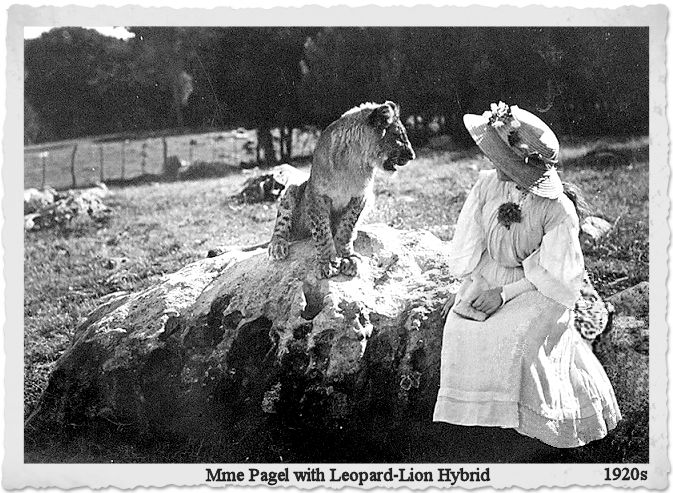
|
HYBRIDS BETWEEN LEOPARDS AND LIONS |
LEOPON (LEPON)
Leopons are the offspring of a male leopard and a lioness. They have been bred in zoos in India, Japan, Germany and Italy (this latter was more correctly a Lipard - offspring of a lion and leopardess). Karl Hagenbeck, who produced many different hybrids, recorded the birth of leopons at the Hamburg Tierpark in Germany, but none survived to maturity. A supposed leopard x lion hybrid was exhibited in Regent's Park Zoo, London. This was more leopard-like than lion-like apart from the rather square head and the large ears. There is also a report of a natural leopard/lioness mating where a lioness was expelled from her pride and formed an alliance with a male leopard. When the lioness came on heat, she was mated by the leopard and allegedly gave birth to leopon cubs. The Marozi is claimed to be a naturally occurring leopard/lion hybrid. However, H Scherren (1908) notes that wild leopard-lion hybrids were unlikely as an encounter between the two species would more likely result in the leopard's death.
“WHAT IS ITS” BORN AT THE CARNIVAL GROUNDS – CROSS BTWEEN LION AND LEOPARD. Palladium-Item (Richmond, Indiana), 18th May 1904, pg 2.
At three o’clock yesterday morning at the Carnival grounds, a pair of hybrids was born to a leopard. These two “what is its” are crosses between a lion and a leopard and this is the first time that this especial cross has ever been produced. At least this is the story told by one of the Ferari employes this afternoon. He said that if these two young cubs live until after time of weaning they will be worth $10,000 apiece easily. The cubs will be named “Richmond” and “Indiana,” after thise city and state.
The Buffalo Enquirer, 24th April 1913: HALF-LION, HALF-LEOPARD. (From Harper’s Weekly.) There was presented to the Zoological society of London recently the skin of a lion-leopard hybrid. The animals was born in India and lived two years. The skin has spots like those of a leopard, but those on the sides of the body are smaller and darker. The stomach is unmarked, and the tail terminates in a tuft like that of the lion. [The leopon skin the London Zoological Society received in 1913 came from the private zoo of a Maharaja.]
HUGE CAT SEEN. New Castle News, 12th March 1926, pg 24. A monster cat, called by natives the nunda, recently attacked the port of Lindi, in Tanganyika, while the writer was stationed there. Native police were killed by some animal and loaded rifles issued to constables. The nunda seen by many natives was like a domestic tabby, but asbigb as a donkey. It was not a lion, judging by its spoor, but it may have been a lion-leopard hybrid. It vanished.
[BARNES ZOO AND CIRCUS] Venice Evening Vanguard (California), 30th April 1925, pg 40: A hybrid lion-leopard is among the other interesting animals on display here. It has spots, but the spots are not as clear as on the leopard which trots around the cage next door. The hybrid is said to have the lion’s roar.

PAGEL'S CIRCUS AND MENAGERIE: During the 1900s - 1920s this circus featured Herr William Pagel, a German-born strongman and animal trainer, and his wife Madame Pagel (Mary Dingdale, a formidable woman from Yorkshire, England, 13 years older than William, whom he met in Tasmania). The circus toured in South Africa and Rhodesia (Zimbabwe). Mary had a pet black-maned (Barbary) lion and the photo shows her with what could be a lion-leopard hybrid (the spots seem too pronounced for it to be a young lion and the ruff shows it to be a young adult). Mary Pagel died in 1939 and William died in 1948.
A leopon "flat study skin and skull" from the Kolhapur Zoo in India (bred in 1910) was donated to the British Museum of Natural History by Lt Col FW Wodehouse of the Junior United Services sometime before 1940. The more famous Japanese leopons are preserved as mounted specimens in Japan.
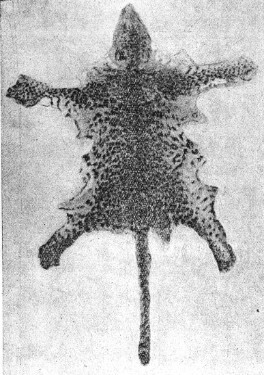
The leopon is documented in R I Pocock's letter to The Field of 2nd November 1912 and the 1913-14 Vol. of the Journal of the Bombay Natural History Society. It refers to three more letters in The Field 1908 April 18, 25, and May 9th. Judging from the letters, the Indian leopons were born in 1910. Pocock wrote in November 1912:
"So far as I am aware there is no published description of a hybrid lion and leopard. I am greatly indebted, therefore, to Mr W S Millard, the Honorary Secretary of the Bombay Natural History Society, for sending me a skin of a specimen, which, according to the testimony of Col F W Wodehouse, was bred in the gardens at Kolhapur between a male panther i.e. a large leopard and a lioness. There were two cubs in the litter. One, whose skin is here figured, died when about two and a half months old, whereas the other, now about two years old is, I believe, still living. At first sight this skin recalls that of the leopard in being covered with spots; but those on the side of the body are much smaller and closer set than in typical Indian leopards, and also browner and altogether less distinct, as if beginning to disappear with age, as is the case with lions. On the head, down the spine, on the belly and the legs, they are however quite black and distinct. The tail is very confusedly spotted above, but striped below, and has a blackish tip covered with longer hairs. Another leonine feature is the dirty white - rather than clear white - tint of the underside, while the ears are fawn with a broad, black bar, but are without the white spot seen in leopards.
The nearest approach to this hybrid hitherto reported is the one bred at Chicago between a male lion and a female cross between a jaguar and a leopard, the true story of which, accompanied by a good figure by Mr Frohawk, may be found in the Field for April 18 and 25, and May 9, 1908. The final episode in the history of that animal has, I believe, not yet been told. After being exhibited in the Zoological Gardens and at the White City it went to Glasgow, where, according to a sensational Press notice, it was killed by a lion, which broke down the partition between the cages and made short work of its opponent. That this story was of a piece with the original account of the hybrid given out when it first appeared on the market may be inferred from the condition of the dressed skin, which had no sign of a tear or scratch upon it in London shortly after the alleged tragedy. The chief difference between this hybrid of three species and the lion-leopard born at Kolhapur lies in the size of the spots, those of the former being large and jaguar-like, as might be expected, while those of the latter are small and more leopard-like."
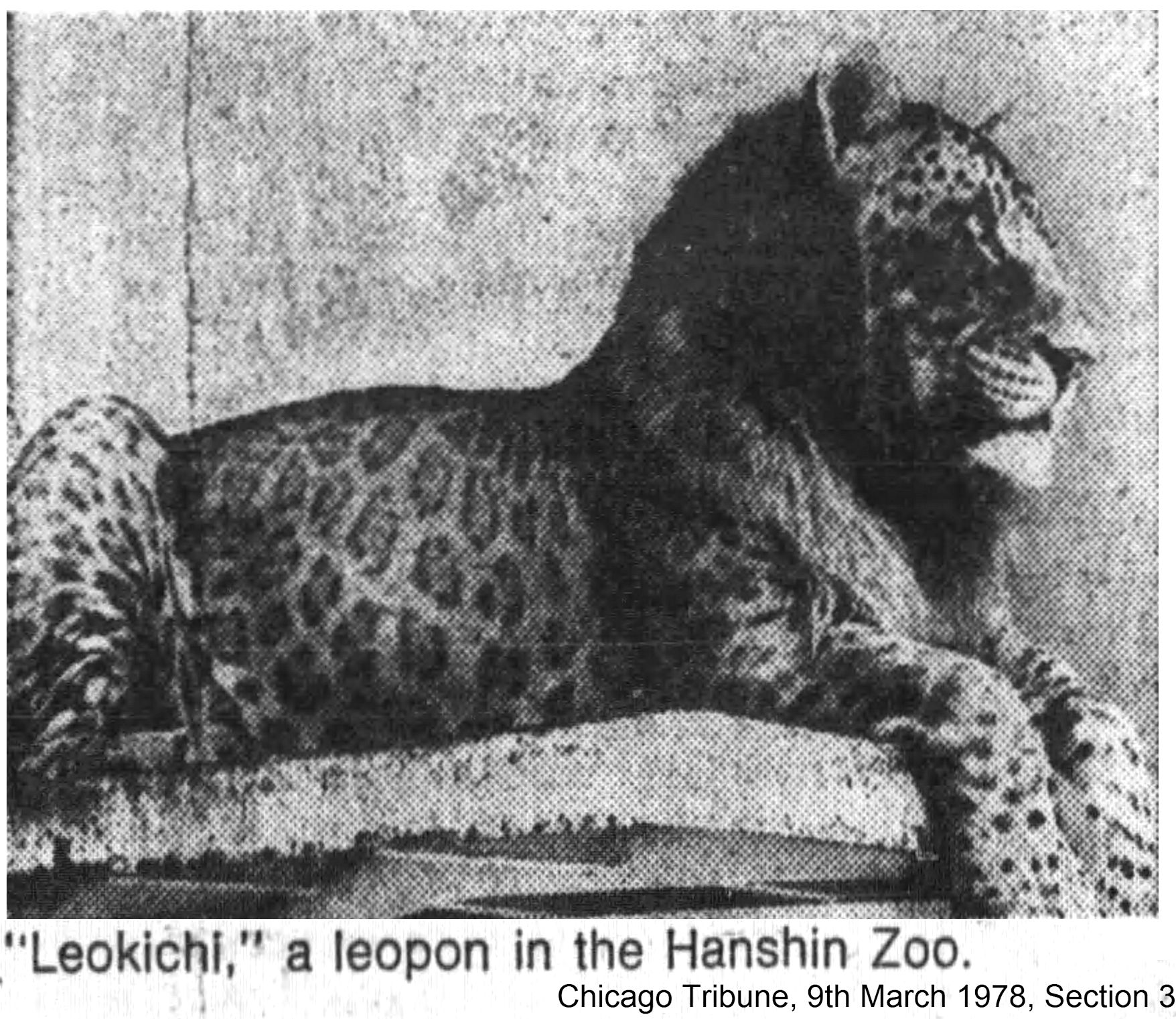
The most successful and famous leopon programme was at Koshien Hanshin Park in Nishinomiya City, Japan. Sonoko the lioness was mated to a leopard called Kaneo. The exotic, spectacular hybrids were popular with the public, but the programme was criticised in zoological and animal welfare circles. Hiroyuki Doi was the director at Hanshin when the leopons were bred. The idea of creating hybrids was discussed during 1954 and the zoo had the choice of breeding lion-tiger or lion-leopard hybrids as they had a good breeding record for all three species. Because other zoos had successfully bred ligers and tigons, they decided on lipards (lion/leopardess) or leopons (leopard/lioness) as they believed these had not been bred before. Each parent was carefully selected. The male leopard, Kaneo, was born at the zoo in January 1955. The female lion cub, Sonoko, was born there in March 1955. They were caged together in December 1955 to get acquainted. According to Doi, for the next 3 years their food was carefully chosen and hormones were added.
The size difference almost caused the plan to be abandoned, but in March and June 1959, three matings were witnessed and the lioness was then closely observed and supervised. Disappointingly she did not show signs of pregnancy, but by the end of September 1959, zoo staff were certain that Sonoko was pregnant. They could not be certain of the due date as lions gestation period is 105-110 days and leopards' gestation period is 90-95 days. Sonoko had 6 formal checkups each day and he cubs were born after 97 days, several days earlier than expected and before Kaneo and Sonoko could be separated. On the morning of 2nd November 1959, Sonoko became restless, trying to hid from staff observing her and her belly had dropped. That afternoon, Kaneo was observed carrying an apparently dead cub around in his mouth. Staff managed to get it from him and give the cub to Sonoko while they isolated Kaneo. To their surprise, the cub was alive and vigourous and the lioness accepted it back in spite of human handling. That night she had a second cub. A litter of 2 hybrids was born in 1959 and 3 more (Johnny, Daisy and Cherry) were born in 1962. In captivity, the normally solitary male leopard remained with the family (social behaviour is sometimes seen in captive big cats).
In terms of size, the leopons take after the lioness mother and are larger than leopards. They have stout lion-like bodies and shorter leopard-like legs. They have brown, rather than black, spots and tufted tails. They will climb like leopards and seem to enjoy water, also like the leopard (oddly enough, the Japanese leopons were born of a water-loving lioness and a male leopard that did not seem to like water!). When mature, males had sparse manes about 20 cm long when adult (Florio, 1983). Females may be torn between the solitary nature of the leopard and the social nature of a lioness. The hybrids proved to be sterile and the last one died in 1985.

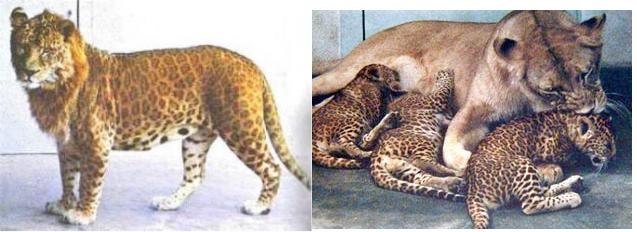
The Edmond Booster (Oklahoma), 21st February 1963, pg 11 mentioned a lion-leopard hybrid in Lincoln Park Zoo, Oklahoma City. ENGLISH MAJOR IS EQUALLY FOND OF SHAKESPEARE, ZOO'S ANIMALS. "Bill [Whitlow] regards the zoo's lion-leopard hybrid as probably the strangest cross-breed ever. The kittens grow to be twice as big and strong as a regular leopard." The zoo also had a “black-tail lion” called Goldie. I can find no further information about this hybrid.
H Hemmer (1966) described leopard/lion hybrids as large animals, larger than the leopard and almost as large as the lioness mother. Males had a beard and mane; the mane developing at 2 years of age and remaining poorly developed at age 3. The background colour was pale reddish-yellow; being more reddish than in a lion. The markings were paler than those of the leopard.
Interestingly, the leopard was originally believed to be a hybrid between the "pard" (old name for panther, this being considered a separate creature from the leopard) and the lion ("leo") i.e. a leo-pard. Nowadays, the term "panther" is generally only applied to black leopards. Pliny believed that leopards were a hybrid of panther (pard) and lioness (leo). This belief held sway for centuries, leading some authorities to identify Dante's Lonza as a leopard/lion hybrid in the style of Pliny. In Dante's book "Inferno" (1314) a leopard-like creature called the "Lonza" represents the sin of lust. Although generally translated as leopard, the word "lonza" is ambiguous (being a play on words) and some identify it as a hybrid of lion/leopardess or leopard/lioness, citing the works of Pliny as possible inspiration for Dante's Lonza.
The Leopons shown here were bred at Koshien Hanshin Park in Nishinomiya City, Japan. Some of the photos show the cats as being extremely overweight, possibly due to a lack of testosterone; predisposing them to lay down fat instead of muscle (life in relatively small cages did not help matters). The lioness mother, leopard father and leopon offspring were taxidermised and are still on display. The park is closing and will donate two stuffed leopons to the National Science Museum in Tokyo for scientific research. The remaining stuffed leopons will be displayed in Nishinomiya City.

TIGER-LION-LEOPARD CROSS ATTEMPTED. The Daily Oklahoman, 7th October 1967.
Tokyo. Japanese zoo officials Frida caged a male tiger with a female lion-leopard cross in an attempt toe produce the world’s first three-way tiger-lion-leopard hybrid which will be called a “tipon.”
LAST LION-LEOPARD CROSS DIES IN JAPANESE ZOO. The Courier Journal, 21st July 1985.
TOKYO (AP) – The last of the “leopons,” a cross between a leopard and a lion, has died of old age at a zoo in western Japan, officials said yesterday. The 24-year-old hybrid, known as Johnny, died Friday. Johnny was one of five leopons born in two litters to a leopard and a lioness at Hanshin Park in Nishinomiya, 250 miles west of Tokyo. Zoo Officials, reached by telephone, said that mating was the first known. Such experimentation was stopped after animal-protection groups complained.
Must a lioness be sedated for the smaller leopard to mount her? Or does she willingly adopt a lying position? Any natural hybrids would require her to be willing. Some have claimed that the zoo pictures below show a very unresponsive, sedated lioness, but reports on the Japanese leopons state that the lioness voluntarily assumed a position on her side to allow the much smaller leopard to mount her. The photos clearly show affection between the two animals.
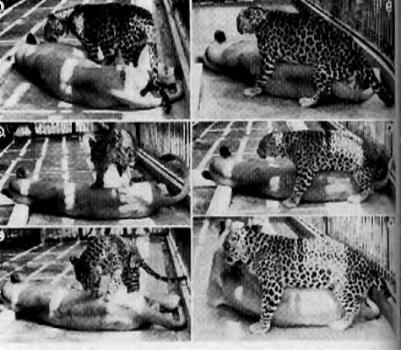
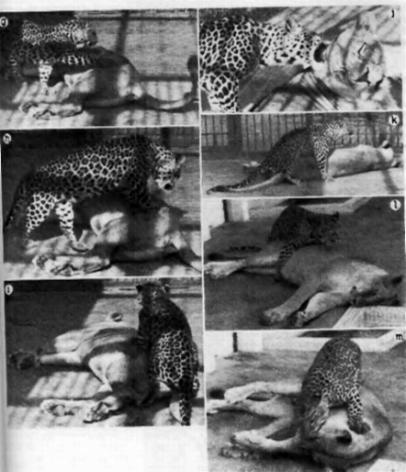
July 8th, 1961: Zoo keepers here have dubbed their latest attraction leopons. The three cubs are offspring of a female lion and a male leopard. Two are yellowish-brown with light black spots. The third leans to the father’s side – spotty.
October 9th, 1967: If all goes well, Japanese zoo experts hope to have by next April the world’s first tippon, a cross between a male tiger and a female leopon. The first leopon, offspring of a leopard and lion was successfully bred eight years ago by these experts. Tiger named Ben, aged 3 years and 10 months, and Miss Daisy the leopon, 6 years and 4 months, were mated last week.
1968: THE STORY OF LEOPONS. Doi, Hiroyuk and Barbara Reynolds. Putnam. Today Japanese children can visit a zoo and see leopons - animals that several vears ago did not exist anywhere in the world. Their mother is a lion and their father is a leopard. Dr. Hiroyuki Doi first believed that lions and leopards were more similar than most people had thought, he felt that perhaps the animals had developed from one common ancestor and his experiment was a plausible testimony to his theory. The book is full of photos of these fascinating creatures.
July 12th, 1971: Hanshin Park Zoo officials reported the death of Sonoko, a lioness who gave birth in 1959 and 1961 to five cubs called leopons because they were fathered by a leopard. Four leopons survive.
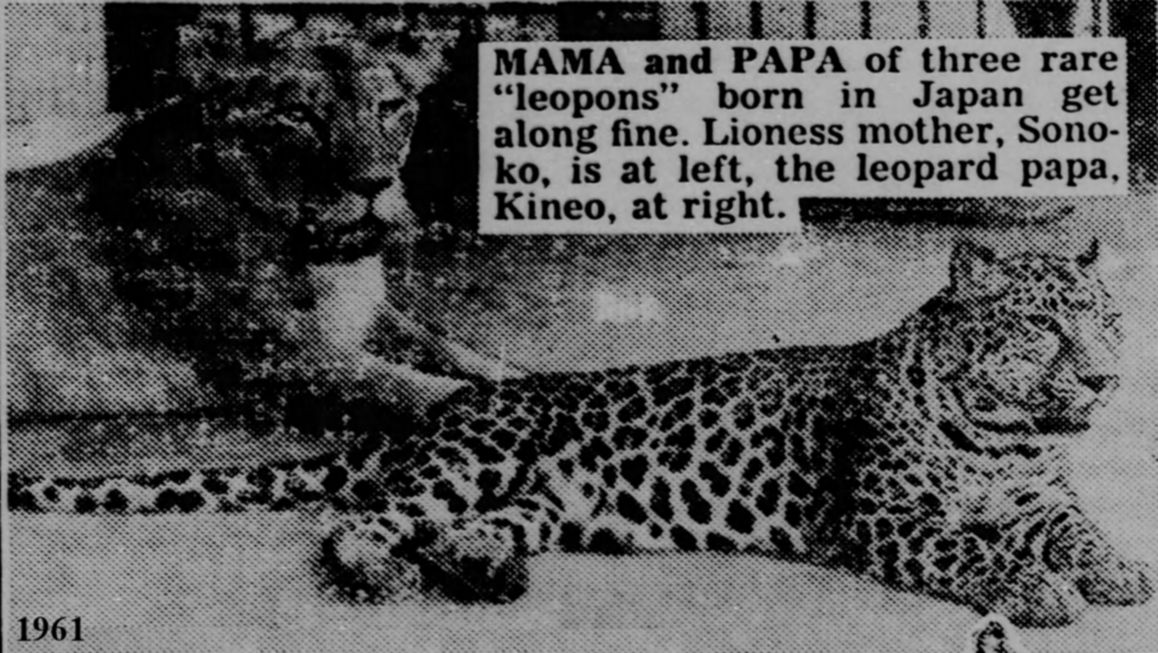
LIARD (LIPARD)
There have been successful attempts to cross a lion with a leopardess to produce liards or lipards (or as Florio proposed "leonards"). The large size of the lion compared to that of the leopardess means that a leopon (male leopard/lioness) is a more plausible explanation for the marozi than a lion/leopardess pairing. A lion x leopardess hybrid was born in Schoenbrunn Zoo, Vienna in 1951. A better documented lipard was born in 1982.
Mr Franco Stenta of Barberino Mugello near Florence. Stenta owned a number of tame big captive-born big cats: 2 male lions, 2 male tigers, 1 tiger cub and a leopardess. These had been acquired from Rome Zoo and were tame to the point of being domesticated. One lion ("Puff"), the leopardess ("Miccia") and the tiger cub were housed in cages in the courtyard of the Stenta family's paper factory in Barberino Mugello 25 km from Florence. The owner did not expect or intend them to breed. The lion/leopard hybrid cub (often called a "leopon" or "reverse leopon" in reports) came as a complete surprise to the owner and at first he mistook it for a domestic cat, which he thought had slipped into the cage.
The father of the hybrid was a 2 year old 250 kg lion 1.08 m tall at the shoulders and 1.8 m long (excluding tail). The mother was a 3 and a half year old leopardess weighing only 38 kg. The female cub was born overnight on 26/27 August 1982. Its estimated birth-weight was similar to that of a leopard cub and the estimated gestation period was 92-93 days. Miccia was initially a good mother, but began to over-groom the cub, biting off its tail when it was 2 days old. From then on, the cub was left with its mother while nursing. After 2 weeks it was hand-reared. At 5 months old it weighed 13-14 kg and was one third the size of its mother. It had the body conformation of a lion cub with a large head (lion trait) but receding forehead (leopard trait), fawn fur and thick but faded (i.e. brown) spotting. The parents mated again in November 1982 and the leopardess was reported to be pregnant. However she had to be kept separate from Puff as he continued to mount her whenever they were together.
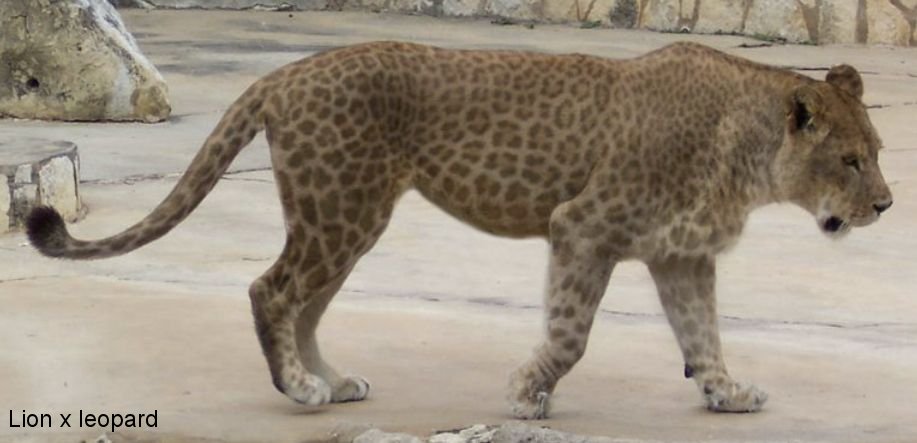
LEOPARD-LION-TIGER HYBRID
These reports, which contain a lot of showman's hype, also allude to a leopard-lion-tiger hybrid. From The New York Times of June 4th, 1906 we have “ALL HYBRIDS AT CONEY. Some Beasts There Are Bi-Hybrids This Year—All Are Mighty Rare. Bulletin chased bulletin out of the animal shows at Coney Island yesterday. A Coney Island animal show is a cheap affair this year if it hasn’t at least one hybrid; naturally the press agents aren't forgetting that fact. Bostock’s press agent announced, with tears in his voiced that “Tricolor,” the Bostock hybrid, had just died. At the same time, however, there were born to the lioness Princess two tiny cubs. Their father is said to be a cross between a puma and “the famous self-eating Jaguar whose favourite occupation is biting a section of his own tail off.” Tricolor was only a cross of a puma, a jaguar, and a lion. That, the press agent says, is quite a common cross. The new cubs, of course, are very rare.” At the same time, various papers reported that “Tricolor,” the Bostock leopard-lion-tiger hybrid, died, and a lioness in Mr. Bostock’s menagerie had given birth to a pair of puma-jaguar-lion prodigies. (Personally, I am dubious because this was a time when showmen were trying to outdo each other with 3-way hybrids following a genuine lion-leopard-jaguar hybrid)
TIGER-LION-LEOPARD CROSS ATTEMPTED. The Daily Oklahoman, 7th October 1967.
Tokyo. Japanese zoo officials Frida caged a male tiger with a female lion-leopard cross in an attempt toe produce the world’s first three-way tiger-lion-leopard hybrid which will be called a “tipon.”
MAROZI
The mysterious African "marozi" or "spotted lion", may be a rare natural leopard/lion hybrid or an adult lion which retained its childhood spots. Descriptions vary, but in general the marozi is described as a small lion with a sandy, tawny or grey coat with tawny spots. To add to the confusion, the spotted patterns are variously described as leopard-like, not leopard-like or even jaguar-like.
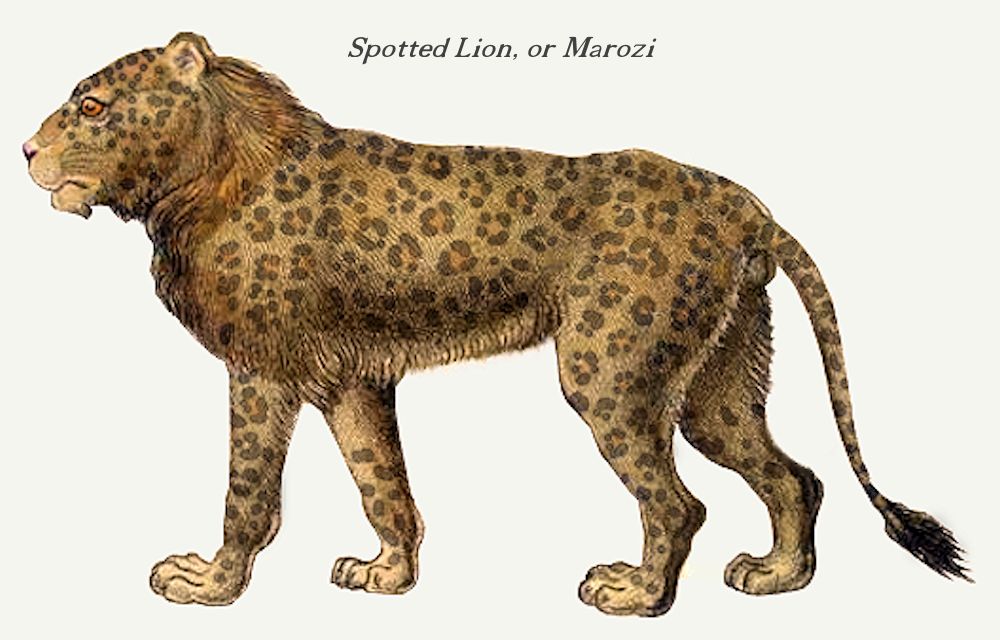
The marozi is reported in Cameroons, Central African Republic, Uganda, Rwanda, Kenya and Ethiopia where it is reportedly a forest-dweller with a unique spot pattern distinct from that of the leopard. The first observations of spotted lions (marozi, Panthera leo maculatus) by westerners were in 1903. Details of marozi/spotted lion sightings is at spotted lions. The presence of a supposedly self-sustaining population (male big cat hybrids are sterile), the small size and the size difference problems of a leopard/lioness mating suggests a mutant form of either leopard or lion. Because male hybrids are rarely fertile, a female leopon would have to mate with either a leopard or lion in order to produce offspring. Those offspring would resemble the pure-bred parent.
BLACK LEOPONS
Black leopards (black panthers) have always caught the public imagination. To my knowledge black leopons have not occurred. The gene for melanism in leopards is recessive and would probably be masked by lion colouration genes.
REFERENCES AND FURTHER READING
Accounts: H Scherren (1908), T Noack (1908), The Field (1908), SS Flower (1929), L Reisinger (1929), O Antonius (1951), H Petzsch (1956), H Doi (1960), International Zoo Yearbook (1960, 1962), H Hemmer (1966, 1968)
Florio PL. Birth of a Lion x Leopard Hybrid in Italy. International-Zoo-News, 1983; 30(2): 4-6
Pocock RI. Letter to The Field of 2nd November 1912
Textual content is licensed under the GFDL.
Many thanks to Paul McCarthy for tirelessly researching back issues of The Field and The Times.
|
BACK TO HYBRID & MUTANT BIG CATS INDEX |